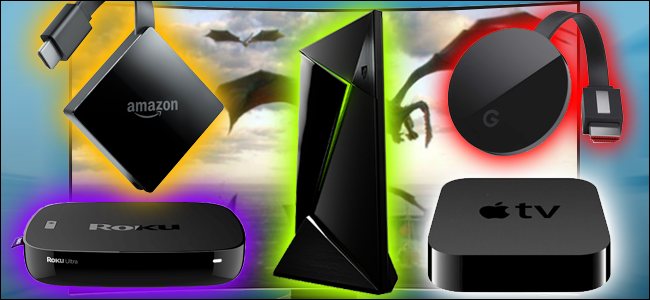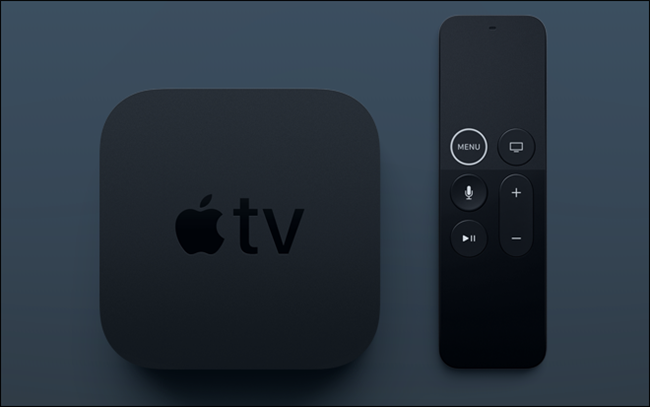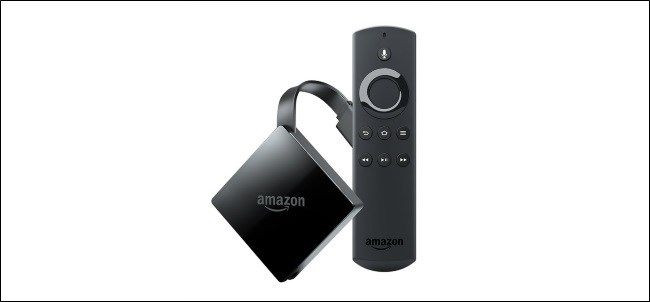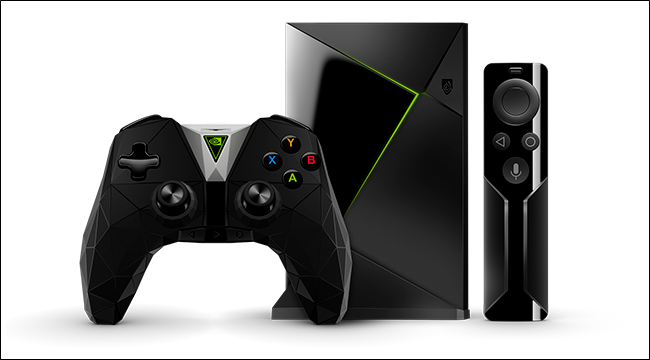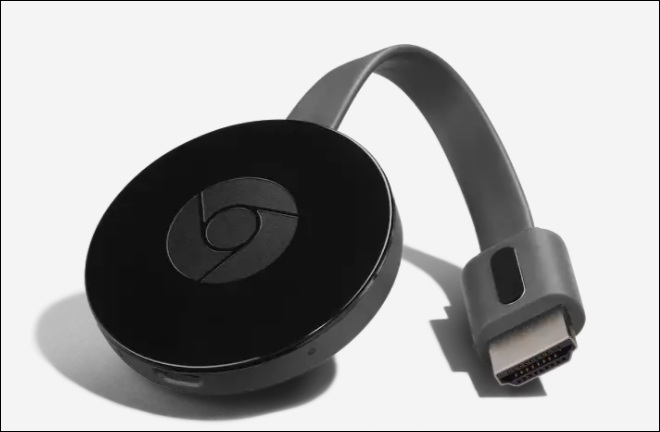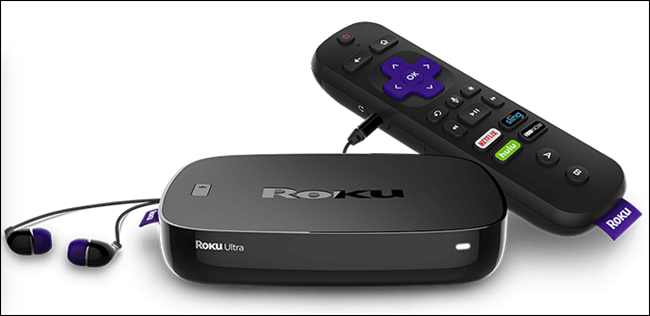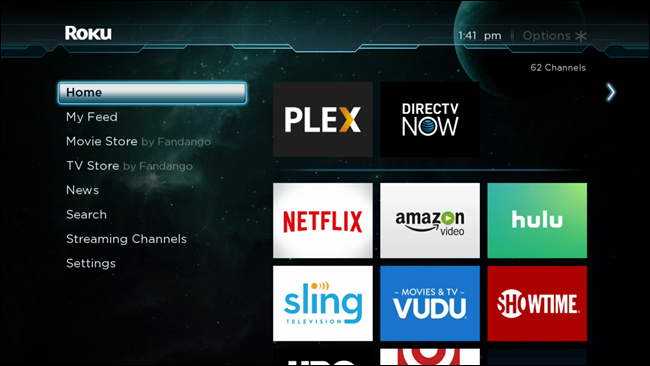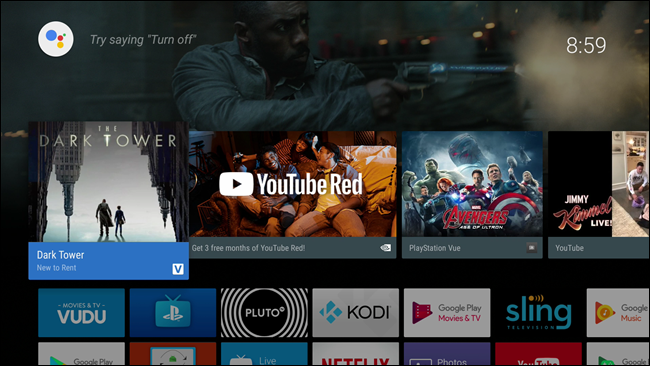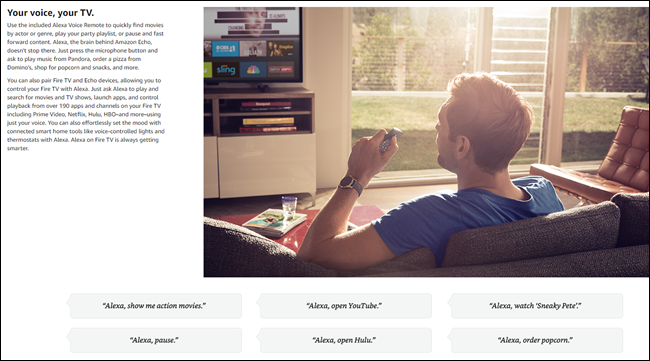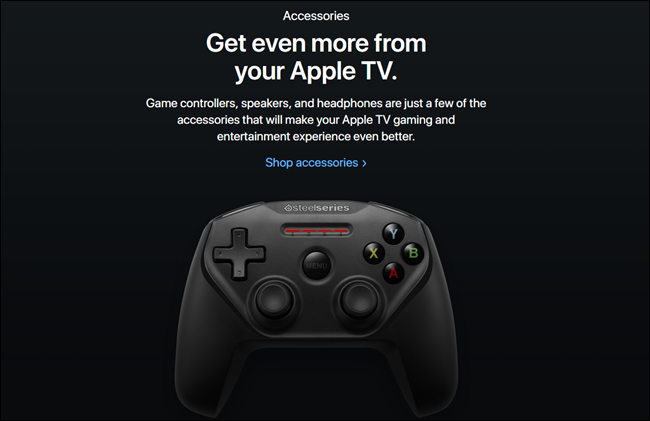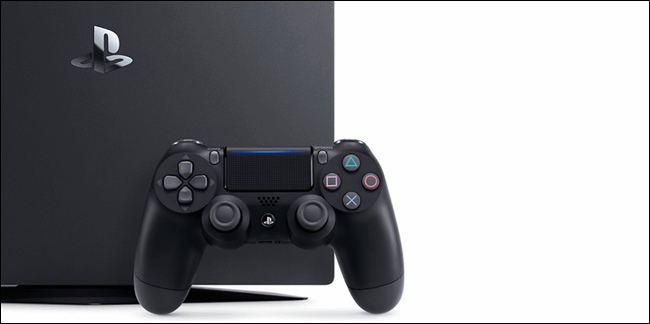Quick Links
It's no secret that "smart" TVs aren't really that smart. Generally, and a dedicated streaming box or stick is the way to go. There are quite a few to choose from, though, so how do you decide which is the best for your movie-viewing needs?
The Contenders
There are five big names in this game: The Amazon Fire TV (and Fire TV stick), the Google Chromecast, the Apple TV, Roku's various boxes, and Android TV (which is more of a full-featured platform than Chromecast, even though they're both Google). Here's a breakdown of each before we get into what makes them different.
Apple TV
This is the for those truly invested in the Apple ecosystem. There are two version of the Apple TV: the Apple TV 4K and the regular Apple TV. The 4K model comes in 32GB ($149) and 64GB ($199) flavors, while the regular Apple TV only comes in 32GB ($149). If you're going for the 4K, I recommend going for the 64GB model because that 4K video will eat up space quickly.
Amazon Fire TV and Fire TV Stick
This is Amazon's take on the streaming box market. Both the Fire TV and Fire TV Stick feature Alexa voice controls and a wide range of apps and games to choose from. The 2017 Fire TV is $69, and can play 4K video; while the smaller, less-powerful Stick goes for $40 and sticks to HD. What a bargain.
Android TV
"Android TV" isn't the name of one set-top box---instead, it's a platform that other manufacturers can use on their own set-top boxes. Even more confusing, not every box that runs Android is an Android TV box.
There are many ways to get Android TV, including built-in to many TVs. But if you want my short answer on which set-top box to get, just buy an NVIDIA SHIELD for $180. It is, far and away, the best Android TV box out there.
Google Chromecast
This is the simplest streaming device on the list---it has no true "interface" on your TV; instead, you bring up an app on your phone (like Netflix or HBO Go) and "cast" video from it to your TV. You can get a "regular" Chromecast for $35, but if you're living that 4K life, you might as well spring for the Chromecast Ultra, which will set you back $70.
Roku
Probably the biggest name in this game, and the one that really started it all. Roku devices are full of innovative features and a nearly incomparable library of apps. And man, there are a lot of Roku products out there---a lot more if you also consider the products that are no longer in production. So here's the short list of current-gen products:
- Roku Express, $30: The simplest, most basic stick Roku offers.
- Roku Express+, $40: This little guy has component inputs for older TVs. That's neat.
- Roku Streaming Stick, $50: Small, compact, and relatively robust.
- Roku Streaming Stick+, $70: A beefier version of the Streaming Stick, which supports 4K and HDR.
- Roku Ultra, $100: The cream of the Roku crop---it supports 4K, HDR, and a bunch of different ports in the back (not to mention a microSD card). Not bad.
That, of course, is a very simplified, one-or-two-sentence look at what each platform is about. The real meat and potatoes here will be all the stuff we're going to talk about down below: the features provided with each different box and now they compare to each other.
What Services Are Available on Each Box?
The Roku home screen, with a few of its many, many apps installed.
Arguably the most important feature of any streaming box is: which services can you watch on it? Not all boxes are created equally here, especially the more specific your needs get. We can't list every possible service here, so make sure to do your own research if there's a specific app or service you want access to on your streaming box. But in general, here's how they compare.
Pretty much all the big names should be compatible with all of these boxes: Netflix, Hulu, YouTube, HBO Now, Showtime, Twitch, and other big channels should be available on every platform (though Amazon Prime Video is not available on the Chromecast or Android TV, except the SHIELD). If you use a streaming TV service---like Sling, PlayStation Vue, YouTube TV, DirecTV Now, or Hulu TV---however, things are going to be a bit harder to pin down.
If that's the case, I highly recommend going directly to your TV provider for device compatibility. For Android TV users, keep in mind that it has built-in casting options, effectively making it a Chromecast as well as a set-top box. So if your provider supports Chromecast, it's also technically usable on Android TV, even if it doesn't have a dedicated interface. That's sort of a half-assed solution if you ask me, but it is a solution nonetheless.
Of course, there are also exclusives. For example, you're not going to get iTunes access anywhere but Apple TV. Google Play is a bit of a mixed bag---Movies is available on Android TV, Chromecast, and Roku, but none of the others. Like I mentioned earlier, Amazon Prime Video is available on Fire TV (of course), Apple TV, and Roku, but it's also exclusively available on NVIDIA SHIELD where Android TV is concerned.
If you're looking for Kodi or Plex support, things get a little harrier. For example, Android TV supports Kodi out of the box, but most of the others require quite a bit of hackjob work to make it happen. Plex, on the other hand, is a little more ubiquitous. It's available on Apple TV, Roku, Fire TV, and SHIELD. It also supports casting from your phone, making it available for essentially all the boxes we're talking about here.
When it comes to sheer numbers of supported services, Roku leads the pack by a mile. It offers thousands of streaming "channels" (read: apps), though I'll admit 80% of them are probably garbage. I'd say the rest of the boxes are fairly even in terms of available apps, though SHIELD will definitely take the crown for games, which we'll talk more about down below.
Which Boxes Are Easiest to Use?
Android TV's home screen, complete with lots of recommendations.
When it comes to ease of use, things tend to get a little convoluted, because what's easy for one person may not seem easy to another---and it may also depend on how you do your TV watching.
What I can say is that most of these boxes are relatively straightforward and easy to use. For the traditional boxes, I'd say Roku is the easiest to use: its interface is very simple with no frills (in a good way). Apple TV and Android TV are both decently easy, but will be most familiar to those who are already familiar with iOS and Android, respectively. Amazon's Fire boxes are probably my least favorite---I find them more convoluted than the others.
Chromecast is a weird beast, since it doesn't use a traditional interface. Some people may find it the simplest option of all, since all you have to do is bring the app up on your phone and tap the Cast button to start watching. If you know your way around a smartphone, you'll find Chromecast dead simple. But for those more used to using a traditional remote and an on-screen interface for the TV, the Chromecast may seem confusing, and something like the Roku will be a better bet.
What Are the Standout Features of Each Box?
Apart from basic usability, each box has some exclusive features that make them more compelling. Which ones matter to you depend on what you're looking to do with your box. Here are the standout features of each:
- Apple TV: The biggest thing here is Siri. It's integrated into Apple TV, so you can talk to it like your phone---and it can do cool stuff like repeat a mumbled line with subtitles enabled, search movies by genre (and sub-genre), check the weather, and more. Otherwise, Apple TV has controller support and a decent game selection thanks to the iPhone and iPad's compatible game library.
- Amazon Fire TV: Like with the Apple TV, Amazon's digital assistant Alexa is along for the ride here. It's not quite as powerful in terms of media control, but it's still cool. Also like Apple TV, Fire TV and Fire TV Stick have game controller support and a decent choice of things to play.
- Android TV: Like with the other sections, Android TV is kind of a mess---only because there are so many boxes. You can keep it simple and cheap, but the more you pay, the more features you get. For example, the NVIDIA SHIELD not only has incredible game support, but also access to Google Assistant, support for Samsung SmartThings, Plex Server integration, and an optional 500GB build. So yeah, you can literally turn your SHIELD into a server. The SHIELD also supports 4K video and private listening via headphone jacks on the remote or game controller.
- Google Chromecast: Simplicity is the selling point with the Chromecast, so you won't find a lot of bells and whistles. Instead, Chromecast is clean, minimal, and easy to use---not to mention cheap (at least for the non-4K version).
- Roku: Like Android TV, there are a lot of options here, each with its own set of features. If you're looking for simplicity and affordability, Roku Express is your huckleberry. But if you're looking for full-featured goodness, Roku Ultra is where it's at. It offers 4K playback, Ethernet, USB, microSD cards, and private listening by plugging headphones into the remote. (Though lower-end Rokus can do this through the mobile app).
How Do the Form Factors Compare?
Form factor may or may not be a big deal to you, and that's okay. Just a couple of years ago, most of these boxes were about the same size, and they were mostly boring squares. Things have changed since then, even if only slightly.
- Apple TV: It's a pretty small, black, non-descript box. Very clean and minimal (like most Apple products), this one is sure to sort of blend into the background in most home theater setups.
- Amazon Fire TV: This is the only full-featured box on the list that is more of a streaming "stick" than an actual set-top box. It literally connects to the TV and then sort of just hangs there...a lot like a Chromecast. The thing is, it packs a huge punch under that tiny hood. Kind of like a toddler. The Fire TV Stick is literally a stick---it plugs in and just sort of stays out of the way. It's weaker, but cheaper, than the Fire TV. Honestly, as affordable as the fully-powered Fire TV is now, I don't even know why the stick exists.
- Android TV: Again, Android TV isn't a box, but a platform. There are a lot of options out there. If you want small and out-of-the-way, go with the Xiaomi Mi Box. It's ultra clean. The SHIELD, however, is a lot more...out there. It's bigger and has a somewhat jagged "gamer" aesthetic. I don't mind the look of the SHIELD, but I can definitely see why some people might.
- Google Chromecast: It's a little dangly circle attached to a short HDMI cable. It just sort of hangs there behind your TV. Not a lot to dislike about that.
- Roku: Roku products can really be broken down into two categories: sticks and boxes. The Express, Express+, Streaming Stick, and Streaming Stick+ are all sticks. They stay out of the way because they're just behind the TV. The Ultra is an actual box, but it's small, thin, and clean. It looks good and isn't gaudy---it should fit in just fine with about any decor.
At the end of the day, most of these boxes are pretty small, so form factor isn't a huge deal. Even the larger boxes are small enough to hide away behind your TV.
Which Boxes Are Support Video Games?
Games aren't something you typically think of from your set-top box, but it's becoming more and more common, and some manufacturers are using to set their device apart from the others. At this point, most of the boxes support some sort of gaming---generally very casual at best---but others have made it more of a trademark.
- Apple TV: While not its claim to fame, there's a pretty decent catalog of games on Apple TV, most of which are just iPad games that you can also play on your TV. And it support made-for-iOS game controllers, for a truly comfortable experience..
- Amazon Fire TV: Gaming was one of the things that Amazon almost pioneered, as it was the first company to bring "real" games and a game controller to an otherwise normal set-top box. The catalog isn't great (since it relies on Amazon's smaller Appstore), but there are definitely some solid pick-up-and-play titles. Also, keep in mind that the gaming situation could be limited by which device you pick up---the Stick is a lot less powerful than the box, so the gaming performance will suffer.
- Android TV: Like most things Android, this is a convoluted topic. Most Android TV boxes support a few rudimentary games, but NVIDIA's SHIELD was truly designed for gaming. There are a ton of exclusive games, including some excellent ports of the great titles of yesteryear. And, it can stream games from your NVIDIA-equipped gaming PC. If gaming on your box is important to you, SHIELD is the best choice.
- Google Chromecast: Chromecast doesn't really have an interface to speak of, so the gaming scene is very...limited. There are some family friendly games you can play on the Chromecast, but it doesn't really have what I'd call true "gaming capabilities."
- Roku: Roku sort of hits that middle ground between Chromecast and Apple TV or Fire TV---there are quite a few very simple, family-oriented games here. There's no gaming controller, but the remote is designed to double as a gamepad of sorts. So yeah, if you don't really care about games and only think of them as a very limited aside for your set-top box experience, Roku is a good choice.
Games are likely secondary to the above categories, but it's nice to know you at least have options in this space.
What Are My Other Options?
All that said---and I feel like I've said a lot here---there's another segment that can easily fit the "set-top box" niche: game consoles. If have you have PlayStation or Xbox, then you already sort of have a set-top box. Modern game consoles support 4K video, have access to Netflix and a slew of other apps, and can really do as much as most of the dedicated boxes out there. If you already have a game console, you probably don't need a dedicated box---unless you really want features like Siri, Google Assistant, or something else mentioned above. Set-top boxes are definitely more useful for those that aren't gamers.
Alternatively, you could build your own home theater PC with something like Kodi or Plex installed. This tends to be more useful for local videos than streaming video like Netflix, and is a truly geeky option for those that want something very specific. Buying a set-top box will be a lot simpler (and cheaper), but if you mind getting your hands dirty and enjoy what a massive pain in the ass building something like a home theater PC is, then by all means. You do you.
So, Which Is the Best?
Here's the deal: there isn't really a "best" box out there---only the one that works best for you. If you're so far deep in the Apple ecosystem you can quote Jony Ive interviews verbatim, then by God get the Apple TV. You'll love it.
If you're all about that Amazon life, the Fire TV is for you---maybe the Fire TV Stick if you want to save yourself like thirty bucks, but whatever.
Android nerds, just get a SHIELD and be done with it. It's a great box and by far the most powerful, versatile option on the list, and unequivocally the best Android box. And that's not just blowing smoke.
Chromecast is for the casual streamer who doesn't want or need a lot of fluff. If you're thinking about getting something simple and cheap for the bedroom TV, this is perfect.
Roku almost pioneered this market, so it has a lot of experience under its belt. The Roku Ultra easily offers some of the best value in set-top boxes, especially if you don't already have loyalty with another company. Plus, the Express+ is the only option that supports RCA outputs, so it works with older TVs. That's good looking out by Roku.

